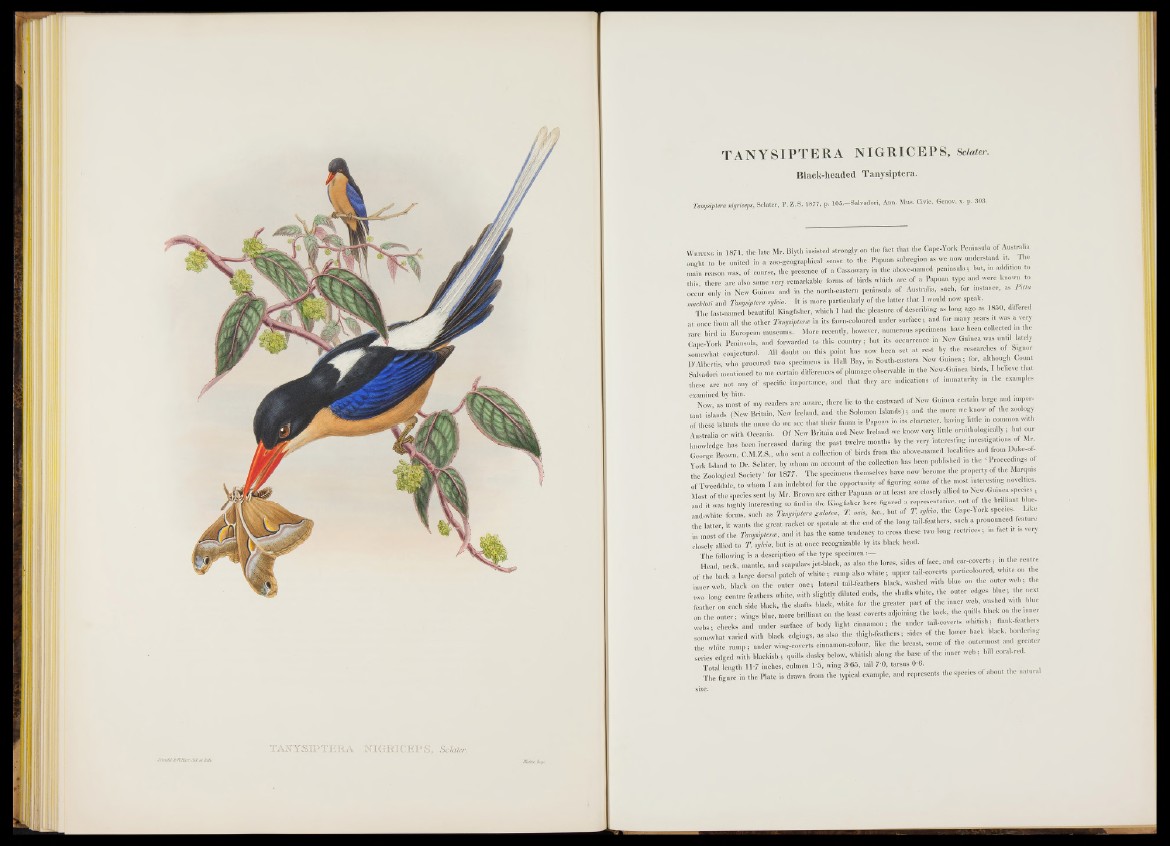
TAHXS3PTEKA N IG H IC E P S , Sdater.
Waha^hnp.
TANYSIPTERA NIGRICEPS, sdater.
Black-headed Tanysiptera.
Tanysiptera nigriceps, Sdater, P. Z. S. 1877, p. I05.-Solvadori, Ann. Mus. Civic. Genov, x. p. 303.
W hiting in 1871, the late Mr. Blyth insisted strongly on the fact th at the Cape-York Peninsula o f Australia
ought to be united in a soo-geographical s e n s e d the Papuan subregion as we now understand it. The
main reason was, of course, the presence of a Cassowary in the above-named peninsula; but, m addition to
this, there are also some very remarkable forms o f birds which are of a Papuan type and were known to
occur only in New Guinea and in the north-eastern peninsula of Australia, such, for instance, as Pitta
mackhti and Tanysiptera sylma. I t is more particularly of the latter that 1 would now speak.
The last-named beautiful Kingfisher, which I had the pleasure of describing as long ago as 1850, diftered
at once from all the other Tanysiptera: in its fawn-coloured under surface; and for many years it was a very
rare bird in European museums. More recently, however, numerous specimens have been collected in the
Cane-York Peninsula, and forwarded to this co u n try ; but its occurrence in New Guinea was until lately
somewhat conjectural. All doubt on this point has now been set a t rest by the researches of Signor
D'Albertis who procured two specimens in Hall Bay, in South-eastern New Guinea; for, although Count
Salvador! mentioned to me certain differences of plumage observable in the New-Gu.nea birds, I believe that
these are not any o f specific importance, and th at they are indications o f immaturity in the examples
examined by him. ^ . . . , ._____
Now as most o f my readers are aware, there lie to the eastward o f New Guinea certain large and important
islands (New Britain, New Ireland, and the Solomon Islands) ; and the more we know of the zoology
of these islands the more do we see th at their fauna is Papuan in its character, having little in common with
Australia or with Oceania. Of New Britain and New Ireland we know very little ormthologically ; but our
knowledge has been increased during the past twelve months by the very interesting investigations of Mr
George Brown, C.M.Z.S., who sent a collection of birds from the above-named localities and from Duke-of-
York Island to Dr. Sclater, by whom an account of the collection has been published in the I Proceedings o
the Zoological Societv ’ for 1877. The specimens themselves have now become the property o f the Marquis
of Tweeddale, to whom I am indebted for the opportunity of figuring some of the most interesting novelties.
Most of the species sent by Mr. Brown are either Papuan o r at least are closely allied to H H n g 1 3
and it was highly interesting to find in the Kingfisher here figured a representative, not of the brilliant blue-
and-white forms, such as Tanysiptera galatea, T. nais, &c„ but of T. MR the Cape-York spec.es Like
the latter, it wants the great racket o r spatule a t the end of the long tail-feathers, such a pronounced feature
in most of the Tanysipterai, and it has the same tendency to cross these two long rectnces ; in tact it is very
closely allied to T. sylvia, but is at once recognizable by its black head.
T h e following is a description of the type specimen:
Head neck, mantle, and scapulars jet-black, as also the lores, sides of face, and ear-coverts; in the centre
of the back a large dorsal patch of white ; rump also w h ite ; upper tail-coverts particoloured, white on the
inner web, black on the outer one; lateral tail-feathers black, washed with blue on the outer web; the
two long centre feathers white, with slightly dilated ends, the shafts white, the outer edges blue; the next
feather on each side black, the shafts black, white for the greater p art of the inner web, washed with blue
on the o u te r ; wings blue, more brilliant on the least coverts adjoining the back, the q u .Is blacl; o n th e inn
webs cheeks and under surface o f body light cinnamon; the under tail-coverts whitish; flank-feathers
somewhat varied with black edgings, as also the thigli-feathers; sides of the lower back black, bordering
the white rum p ; under wing-coverts cinnamon-eolour, like the breast, some of the outermost and greater
series edged with blackish ; quills dusky below, whitish along the base of the inner web; bill coral-red.
Total length 11*7 inches, culmen 1*5, wing 3*65, tail 7 ’0, tarsus 0*6. W B U f ,
T he figure in the Plate is drawn from the typical example, and represents the species o f about the natura
size.